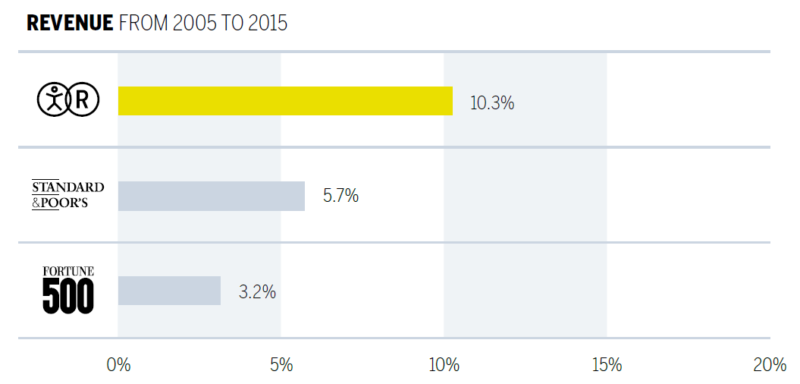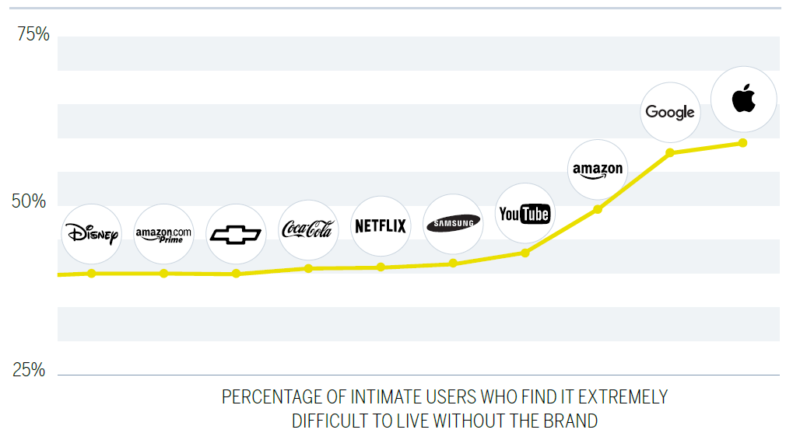But do you love me? A brand intimacy agency ranks brands based on emotional connections to consumers
MBLM's 2017 brand intimacy report ranks 386 brands across 15 industries based on emotional connections brands have with consumers.

Everyone has a favorite coffee brand, or maybe a tech brand they are forever tied to — standing in line to buy the latest gadget at every launch. I recently began jogging in Hoka running shoes, and it’s not a far stretch for me to use the word love when recommending them to others.
But how much do consumers actually love a brand, and is it even something you can measure?
MBLM, billing itself as a brand intimacy agency, believes it’s not only possible to rank the emotional bonds between a person and brand, but says the top-ranked intimate brands have continued to outperform the top S&P 500 and Fortune 500 organizations when it comes to revenue growth.
The brands people love to love
In its recently released Brand Intimacy Report for 2017, MBLM ranked 386 brands across 15 industries from three different geographic areas — the US, Mexico and the United Arab Emirates. According to their findings, the following brands ranked as the most intimate brands of 2017.
MBLM’s top 10 most intimate brands in 2017
- Apple
- Disney
- Amazon
- Harley Davidson
- Netflix
- Nintendo
- Samsung
- Whole Foods
- BMW
- Toyota
Yes, these brands are well-known, and they often rank high in other brand ranking reports, but what exactly is MBLM measuring?
How do you measure love connections between brands & consumers?
According to MBLM’s report, the top 10 brands overall scored high when it came to building emotional bonds and deep connections with their customers and creating stronger attachment and engagement.
To determine the depth of the “emotional bonds” between consumers and brands, MBLM surveyed 6,000 people, age 18 to 64, with annual household incomes of $35,000 or more. Per the agency’s methodology, its 20-minute survey aimed to understand “the extent to which consumers have relationships with brands and the strength of those relationships.”
MBLM says the survey included sorting exercises that allowed them to evaluate the strength of a consumer’s connection to a brand. It also asked questions around the consumer’s usage and satisfaction level with key brands, whether or not they would recommend a brand, and the extent to which they could — or couldn’t — live without a brand.
Survey respondents were also asked to rate brands based on attribute and benefit statements. “These ratings formed the basis of our modeling process,” says MBLM on its Methodology Page.
The brands were then ranked using MBLM’s Brand Intimacy Quotient score, a composite metric that measures the depth of the relationship between a brand and its audience, and the overall usage of the brand.
“The higher the Quotient score, the more intense the emotional relationship with a brand.”
MBLM’s rankings vs. other brand reports
MBLM says it wants to shift the paradigm around the way brands are created, promoted and managed.
“We now know that 90 percent of all decision is based on emotion,” reads the MBLM Brand Intimacy report. “We know for brands to succeed, they need to be emotive, distinct and immediately understood.”
The agency says traditional methods of brand measurement fail to consider how brands and consumers are engaging, and brands must build a relationship with consumers.
If you compare MBLM’s top 10 rankings with Interbrand’s 2017 Best Global Brands Rankings, a well-regarded industry rankings list, six of the brands ranked by MBLM made it into the top 15 on Interbrand’s list: Apple (which also ranked #1 on Interbrand’s list), Amazon (#5), Samsung (#6), Toyota (#7), BMW (#13) and Disney (#14).
Harley Davidson and Netflix also made Interbrand’s top global brands list, but both were much farther down the rankings, with Harley Davidson at #77 and Netflix at #78.
Neither Nintendo nor Whole Foods made Interbrand’s rankings.
Emotionally connected brands see bigger revenue gains
It’s worth noting that revenue growth numbers do back up MBLM’s findings when analyzing how the top-ranked intimacy brands compare to the top-performing S&P 500 and Fortune 500 organizations.
MBLM compiled the top 10 companies from its rankings report, S&P’s rankings and Fortune 500 list, and then compared revenue growth from 2005 to 2015 for each set of top-ranking companies.
MBLM found its top-ranking companies experienced a 10.3 percent growth in revenue over the 10-year period, while the S&P’s top companies saw only 5.7 percent growth, and Fortune 500 saw 3.2 percent growth.
Revenue growth for MBLM’s top brands vs. S&P 500 vs. Fortune 500

There were similar results when MBLM compared profit growth.
The top social brands & the brands consumers can’t live without
In addition to the report, MBLM also offers a ranking tool that lets users filter its survey results by the three geographies, 15 different industries, age of survey respondent, their gender and income level.
Interestingly, not one of the top 10 social platforms and apps made it into MBLM’s overall top 10 list (although Apple Music did make it to #6).
MBLM’s top 10 social apps & platforms based on Intimacy Quotient rankings
- Spotify
- Snapchat
- Apple Music
- Pandora
- Seamless
MBLM also included a breakout of brands consumers can’t live without in its report. It turns out Apple and Google beat out Amazon, YouTube, Netflix and Amazon Prime.
MBLM’s brands consumer’s can’t live without

Among the observations made by MBLM, a clear sign of the times is how well escapist brands performed in its rankings this year. The report noted how high media and entertainment brands like Netflix, Nintendo, Xbox, HBO, Disney ranked — all brands offering an escape from one’s day-to-day responsibilities.
“The ability to disconnect and retreat seems to be growing more popular in the US,” claims MBLM. “Binge watching favorite programs or gaming are dominant (and relatively inexpensive) ways to bring calm and joy into our lives.”
Contributing authors are invited to create content for MarTech and are chosen for their expertise and contribution to the search community. Our contributors work under the oversight of the editorial staff and contributions are checked for quality and relevance to our readers. MarTech is owned by Semrush. Contributor was not asked to make any direct or indirect mentions of Semrush. The opinions they express are their own.
Related stories